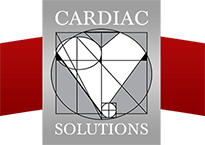“We didn’t want to open an ASC in spite of the hospital systems, it just felt better and more in line with what our relationship had been through the years of collaboration together.”
– Laurie Duvall, RN, BS-HCA, MBA, MBA-HCA
Practice Administrator
Cardiac Solutions

Associate Vice President for the Cardiovascular Service Line
Banner Health

Practice Administrator
Cardiac Solutions
Kristi McShay, associate vice president for the Cardiovascular Service Line at Banner Health, and Laurie Duvall, RN, BS-HCA, MBA, MBA-HCA, practice administrator at Cardiac Solutions, discuss comprehensive strategies for developing an Ambulatory Surgery Center (ASC).
What was the driver for opening your ASC?
Kristi McShay
Banner had decided early on that there was value in an ASC strategy across the organization, and we decided that we wanted cardiology and vascular care to be a part of that. And in doing that, we wanted to recognize that it was a step along the continuum of care, it had a fit and a place in creating value, in creating an appropriate lower cost setting.
Because of the shift to the ASC, we need to create more opportunities for the capacity that was going to be vacated at the hospital, for example, so we’re working right now with Cardiac Solutions on growing our structural heart program to backfill some of that. Looking at our insurance product through a clinically integrated network and really leveraging our partnership to grow and sell that to more payers.
Laurie Duvall, RN, BS-HCA, MBA, MBA-HCA
For Cardiac Solutions, the ASC was just one prong of what we call the triple prong approach:
- A clinically integrated network
- The opportunity to have a co-management agreement for the CV service line at the three Banner facilities at which we provide services.
- The ASC.
If we look at a larger perspective of how we best provide patient care and you look at integrating the care seamlessly through those different venues, it was just an easy decision for Cardiac Solutions.
Why a Joint Venture with a Health System?
Kristi McShay
One of the reasons that Cardiac Solutions was such a big partner for our first physician joint venture ASC is that they provide a lot of support and consistency to their patients, so we knew that that would serve them well in making these decisions around what was best for patients and really ensuring that their patients were not only comfortable with them but would follow them.
The co-management agreement has been really instrumental in bringing our hospital leadership together with Cardiac Solutions leadership, and certainly, the ASC is an important part of that, but it’s not the only part of the overall story – it’s about alignment. They’re not doing it on their own. The health systems can bring access to capital, bring managed care contracts, and bring a patient flow through a PCP network or in Banner’s case, an insurance product.
Laurie Duvall, RN, BS-HCA, MBA, MBA-HCA
Early on, we considered opening our own ASC and hire an independent person with ASC expertise to manage it. We looked at partnering with another national organization, and when we were doing our due diligence of the different models, a partnership with Banner Health and Atlas Healthcare Partners just felt like we were doing this for reasons beyond financial ones.
We were truly doing it for our patients, who are at the center of everything we do. We were banding our cardiology service lines together to be innovative in what we’re offering the patient. In the end, we just felt there was more value in partnering with Banner.
Have you experienced hesitancy from your physicians?
Laurie Duvall, RN, BS-HCA, MBA, MBA-HCA
One of the interventionalists said a patient, when asked about getting a procedure in the ASC, said “Sign me up. Let’s do it” It’s a quick in out, you don’t have to go through registration at the hospital, there’s less risk and they’re probably going to pay less money out of pocket. The patients are having no problems whatsoever. My experience with the interventionalists’ attitude is that they are positive as long as they can appropriately determine which patient is appropriate for the ASC. The electrophysiologists and the device implant staff are extremely comfortable. They have no issues. There’s a learning curve with the cardiologists because they have to get used to the staff and resources to know what kind of cases to bring to the ASC and how complicated the case can be, but I really see them adopting very easily. We’ve not had any concerns so far.
What kind of barriers have you experienced?
Kristi McShay
From our perspective on the health system side, our concern was really around creating a level playing field for multiple practices that we work with in our hospitals because many other practices in our market wanted the opportunity to at least consider an investment in an ASC. That can be kind of a difficult path to navigate. So, deciding early on what our overall strategy around alignment was, what kind of commitment we were going to ask for related to that, and of which the ASC investment was a part of, and what we were prepared to give ourselves was really important. We were very transparent, and Cardiac Solutions joined some of those conversations with other independent practices.
Secondly, I will say, I really underestimated the very special expertise it takes to be successful in the ASC world. I really did not have a lot of exposure to freestanding CV ASCs until the Banner / Atlas Healthcare partnership was formed.
Having our partnership with Atlas Healthcare and bringing that expertise at a really deep level around procedures and appropriateness and clinical care, most importantly, but also their ability to develop highly accurate financial proformas around, not just the center, but what the partnership might look like, capital investment, that is a very specialized area.
Laurie Duvall, RN, BS-HCA, MBA, MBA-HCA
I’d say it was smooth the entire time, but it probably wasn’t. The best piece of advice that I have is to take your time. Work with attorneys who are experienced in this area because there can be a lot of anxiety in partnering with a system and you need to make sure that both parties are heard and understand the agreements. Losing control is probably the biggest concern from a group of independent cardiologists, so ensuring understanding of the agreement(s) is critical.
From my perspective, I needed all my interventionalists to understand all of this legal language, so retaining counsel who could translate between their language and a language that we could understand was of the utmost importance towards everybody felt like they were on a level playing field when they signed the document. And that takes time.
There are things to consider as you work through those documents: what the out strategy is, what is the buy-in, what is the buy-out, what happens if you need to remove somebody. There are things that you just don’t even think of until you start working through that process. Making sure that everybody is informed of what can happen in different scenarios added to everybody’s comfort.


